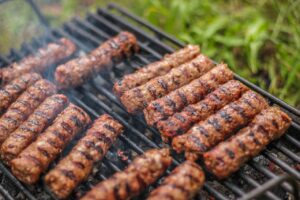Key Takeaway:
| Topic | Content |
|---|---|
| Importance of Sanding | Learn why sanding is crucial for maintaining your griddle |
| Materials and Tools | Discover the necessary equipment for successful sanding |
| Step-by-Step Procedure | Follow an easy guide to properly sand your Blackstone griddle |
| Benefits of Sanding | Explore the advantages of regular griddle sanding |
| Tips and Precautions | Find useful tips and important precautions for sanding |
Introduction:
Sanding your Blackstone griddle is an essential maintenance task to ensure its longevity and optimal cooking performance. By removing rust, debris, and imperfections, sanding helps to restore the smooth surface of your griddle, providing a great cooking experience every time. In this how-to guide, we will take you through the step-by-step process of sanding your Blackstone griddle, highlighting the materials and tools required, along with the benefits and precautions to keep in mind.
Materials and Tools:
Before you begin sanding, gather the following materials and tools:
- Coarse sandpaper (60-80 grit): For initial rust or debris removal.
- Medium sandpaper (120-150 grit): For smoothing the surface after initial sanding.
- Fine sandpaper (220-320 grit): For achieving a polished finish.
- Sanding block or electric sander: To provide consistent pressure and control during sanding.
- Protective gloves: To shield your hands from the rough surface and chemicals, if using any.
- Safety glasses: To protect your eyes from debris.
- Mild soap and water: For cleaning the griddle before and after sanding.
- Clean cloth or towel: To wipe away excess moisture and debris.
Step-by-Step Procedure:
- Prepare the griddle: Remove any food residue or grease from the griddle surface using a scraper or spatula. Clean it thoroughly with mild soap and water to ensure a clean sanding surface.
- Select the appropriate sandpaper: Depending on the initial condition of your griddle, start with coarse sandpaper (60-80 grit) to remove rust or debris. Use medium sandpaper (120-150 grit) to further smooth out the surface. Finish off with fine sandpaper (220-320 grit) for a polished finish.
- Attach sandpaper to your sanding block or electric sander: Ensure the sandpaper is securely fixed to avoid slipping during sanding.
- Begin sanding: Hold the sanding block or sander and apply even pressure on the griddle surface. Move the sandpaper in circular or back-and-forth motions, covering the entire surface area.
- Repeat the sanding process: Gradually progress from coarser to finer sandpaper, ensuring you remove all rust and imperfections. Regularly check your progress by wiping away debris and inspecting the surface.
- Clean the griddle: After sanding, clean the griddle with mild soap and water. Remove any remaining debris or dust from the surface using a clean cloth or towel.
- Season the griddle: To protect the newly sanded surface, apply a thin coat of vegetable oil or griddle seasoning. Heat the griddle to a high temperature, allowing the oil to penetrate and create a protective layer.
- Regular maintenance: Repeat the sanding process whenever needed to maintain the smoothness and integrity of your griddle surface.
Benefits of Sanding:
Sanding your Blackstone griddle offers several benefits, including:
- Enhanced cooking performance: A smooth griddle surface ensures even heat distribution, preventing food from sticking and promoting uniform cooking.
- Rust prevention: Regular sanding helps remove rust and prevents its accumulation, extending the lifespan of your griddle.
- Improved aesthetics: Sanding restores the sleek appearance of your griddle, making it an appealing addition to your outdoor cooking space.
- Long-term cost savings: Proper maintenance through sanding can prevent the need for expensive repairs or replacement down the line.
Tips and Precautions:
- Always wear protective gloves and safety glasses to prevent injuries during the sanding process.
- Follow the manufacturer’s guidelines and recommendations for sanding and maintenance.
- Avoid using excessive force while sanding, as it may damage the griddle surface.
- Regularly clean your griddle after use and season it to maintain its quality and prevent oxidation.
- Store your griddle in a dry and covered area when not in use to protect it from the elements.
- If using chemical cleaners during the sanding process, ensure they are safe for use on griddles and follow the instructions accordingly.
Conclusion:
Regularly sanding your Blackstone griddle is a crucial step in its maintenance, ensuring optimal cooking performance and prolonging its lifespan. By following the step-by-step guide provided, using the appropriate materials and tools, and keeping in mind the benefits and precautions, you can restore and maintain a smooth, rust-free griddle surface. Remember, proper maintenance leads to an enjoyable outdoor cooking experience for years to come.
List: Advantages of Sanding Your Blackstone Griddle
- Enhanced cooking performance
- Rust prevention
- Improved aesthetics
- Long-term cost savings
Table: Materials and Tools Needed for Sanding
| Item | Purpose |
|---|---|
| Coarse sandpaper (60-80 grit) | Initial rust or debris removal |
| Medium sandpaper (120-150 grit) | Smoothing the surface after initial sanding |
| Fine sandpaper (220-320 grit) | Achieving a polished finish |
| Sanding block or electric sander | Providing consistent pressure and control during sanding |
| Protective gloves | Shielding your hands during sanding |
| Safety glasses | Protecting your eyes from debris |
| Mild soap and water | Cleaning the griddle before and after sanding |
| Clean cloth or towel | Wiping away excess moisture and debris |
